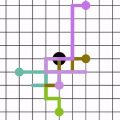Random walk based node embedding algorithms learn vector representations of nodes by optimizing an objective function of node embedding vectors and skip-bigram statistics computed from random walks on the network. They have been applied to many supervised learning problems such as link prediction and node classification and have demonstrated state-of-the-art performance. Yet, their properties remain poorly understood. This paper studies properties of random walk based node embeddings in the unsupervised setting of discovering hidden block structure in the network, i.e., learning node representations whose cluster structure in Euclidean space reflects their adjacency structure within the network. We characterize the ergodic limits of the embedding objective, its generalization, and related convex relaxations to derive corresponding non-randomized versions of the node embedding objectives. We also characterize the optimal node embedding Grammians of the non-randomized objectives for the expected graph of a two-community Stochastic Block Model (SBM). We prove that the solution Grammian has rank $1$ for a suitable nuclear norm relaxation of the non-randomized objective. Comprehensive experimental results on SBM random networks reveal that our non-randomized ergodic objectives yield node embeddings whose distribution is Gaussian-like, centered at the node embeddings of the expected network within each community, and concentrate in the linear degree-scaling regime as the number of nodes increases.
翻译:随机以行走为主的嵌入节点算法通过优化节点嵌入矢量的客观功能和从网络中随机行走计算出的跳比格统计来学习节点的矢量表达方式。 它们已被应用于许多监管的学习问题, 如链接预测和节点分类, 并展示了最新性能 。 然而, 它们的属性仍然不易理解 。 本文研究随机行走为主的节点嵌入网络中未受监督的发现隐藏块结构的设置的矢量表达式的特性, 即学习在 Euclidean 空间的组群点结构反映其网络的相近性结构的客观功能。 我们描述嵌入目标、 目标、 目标、 目标、 目标、 目标、 目标、 目标、 目标、 目标、 目标、 目标、 目标、 目标、 目标、 目标、 目标、 目标、 目标、 目标、 目标、 目标、 目标、 目标、 目标、 目标、 目标、 目标、 目标、 目标、 目标、 目标、 目标、 目标、 目标、 目标、 目标、 目标、 目标、 目标、 目标、 目标、 目标、 目标、 目标、 目标、 目标、 目标、 目标、 目标、 目标、 目标、 目标、 目标、 目标、 目标、 目标、 目标、 目标、 目标、 目标、 目标、 目标、 目标、 目标、 目标、 等、 等、 等、 等、 等、 等、 等、 等、 等、 等、 等、 等、 等、 等、 等、 等、 等、 等、 等、 等、 等、 等、 等、 等、 等、 等、 等、 等、 等、 等、 等、 等、 等、 等、 等、 等、 等、 等、 等、 等、 等、 等、 等、 等、 等、 等、 等、 、 等、 等、 等、 等、 等、 等、




